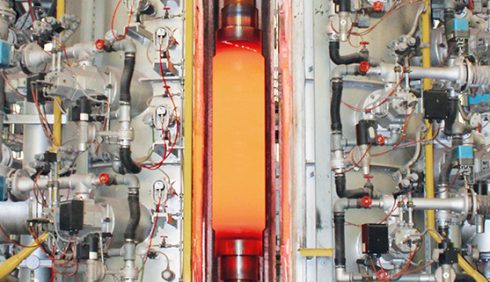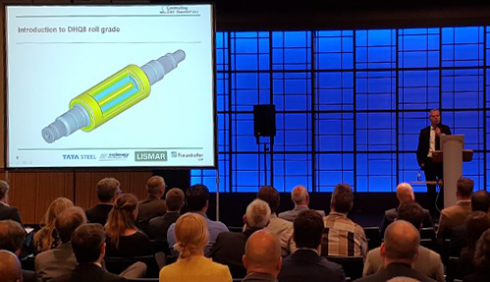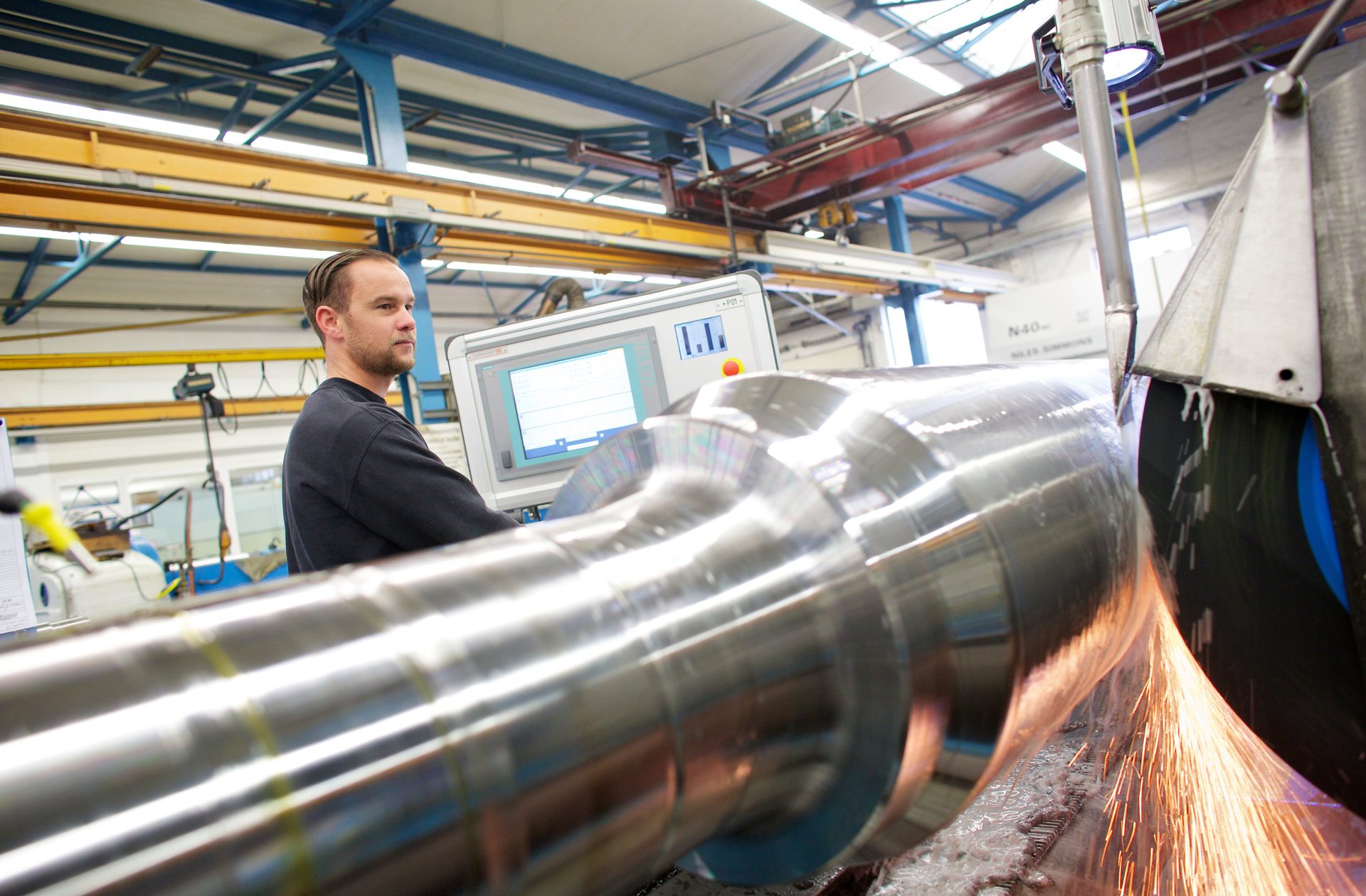STATIONARY ROLL
Special hardening systems that are globally unique have resulted from Steinhoff’s great wealth of experience and its ongoing research and development activities. Our company developed these systems and they are controlled by modern computers.
The central idea here is the stationary roll: Heating and quenching units are mobile while the roll does not change its position.


HARDENING
he benefit of Steinhoff’s hardening is that the time between the cessation of heating and the commencement of quenching is minimised. This means that it is no longer necessary to increase temperatures to compensate subsequent cooling, which in turn means that it is possible to create an optimum microstructure in conjunction with the maximum achievable hardness.
Our balanced combination of austenitising temperature and time is of great importance to the properties of a high-performance roll.
TOTAL BARREL HARDENING (TBH)
It is possible to achieve the balanced distribution of tension and an even progression of hardness across the entire barrel length through the application of classic hardening methods. A lower proportion of austenite and a high proportion of undissolved carbides remain. The computer-guided temperature control makes it easy to reproduce barrel hardening on a wide variety of roll types and barrel shapes thus making it possible to achieve highly homogeneous structures and hardness profiles.


INDUCTION HARDENING
We employ induction hardening in a targeted manner to broaden the range of our heat-treatment performances.
We are very proud of our ability to partially harden almost any section of the journals to satisfy customer requirements and the ability to adapt hardening depths to demands through the application of variable frequencies.
Advancing induction hardening is used not only particularly on rolls that cannot be drilled but also for secondary-hardening materials. It is our main goal to meet the demands made by the highly variable roll geometries and fulfil the high standards of quality that apply to hardening. This we achieve by self producing the inductors.
WHAT WE MEASURE OURSELVES BY:
OUR MACHINERY
Our highly specialised modern machinery is being continuously developed in accordance with our demands so that it always reflects the latest state of the art. We currently run 16 lathes with and without CNC controls, a CNC travelling-column milling machine and a CNC lathe-milling centre. We also operate eight grinding machines equipped with the latest control technologies.
All machining tools are generously dimensioned to match the weight and dimensions of our rolls. That means that we’re also on request able to carry out special machining tasks on them. Our high-performance lathes, milling and grinding machines permit rolls weighing up to 12.5 tonnes, with diameters of up to 1,050 millimetres and total lengths of up to 6,000 millimetres to be machined. We’re even able to machine work pieces up to lengths of 8,000 millimetres and diameters of up to 1,200 mm on our modern travelling-column milling machine.

MECHANICAL MANUFACTURING EXPERTISE
Our specialities include unlimited machining capabilities for hardened and unhardened roll surfaces that have been made from a wide variety of materials and geometries.
CNC milling for a wide variety of drive geometries, e.g. flat journal, square, cloverleaf, splines and multi-groove drives.
CNC grinding for various barrel geometries, e.g. CVC grinding, hollow and crown grinding and cone grinding on roll journals. CBN grinding technology for cost-effective machining for demanding roll materials and surfaces.
The grinding process is complemented by machine-integrated, non-destructive testing techniques.
- Ultrasonic testing from the roll surface to the core to detect the smallest of imperfections.
- Vibration monitoring for realising the finest of finishing requirements.
TECHNOLOGY CONCEPT
Steinhoff’s technology concept is characterised by numerous research and development activities. All departments are always involved in both the planning and processing of research-and-development projects to ensure a holistic approach. It is our aim to continuously optimise customer processes. To this end, we’re always looking to the future so that we’re able to eliminate errors before they cause any issues for our customers. Our activities focus on the three core areas of materials, products and processes.
RESEARCH & DEVELOPMENT ACTIVITIES

- The further development of our product portfolio, our materials, our methods and our processes has been continuously driven forward since the company was established in 1908. A tradition that obliges! A fact that’s demonstrated by our most recent projects that have been briefly profiled below.
- Steel network – resource-efficient production of components made from high tensile steel; funded by the Bundesministerium für Wirtschaft und Energie (BMWi – Federal Ministry for Economic Affairs and Energy) within the framework of the Zentrales Innovationsprogramm Mittelstand (ZIM – Central Innovation Programme for small and medium-sized enterprises (SMEs))
- Future Roll – quenching tool for the flexible hardening of future generations of rolls; funded by the BMWi within the ZIM programme
- IWAS – galvanically and tribologically induced hydrogen embrittlement of forged cold rolls; funded by the BMWi within the PRO INNO II programme
- HEROLL – Hydrogen Embrittlement of Cold Rolls; supported by the RFCS
- Working group within the Deutsche Gesellschaft für Materialkunde (DGM – German Materials Society) for roll cladding – consulting with the working group and supply of rolls for a rolling mill for testing
- Assessment of the size distribution of inclusions with regard to the fatigue strength of high-tensile steel materials; participation in the project-accompanying committee; funded by the Arbeitsgemeinschaft Industrieller Forschungsvereinigungen (AiF – Federation of Industrial Research Associations)
- Development of a new steel grade for cold rolls; internally funded project aimed at developing a new tool steel that possesses a particularly homogeneous microstructure and avoids carbide lines or nets although 10% chromium is added to the alloy
- Development of a gas furnace for ultra-fast heating of forged rolls while saving resources; funded by the BMWMEV and the EU under the ERDF programme
- Determination of near-surface residual stresses in rolls using ultrasonic methods; funded by the BMWi within the framework of the PRO INNO programme
- Cryogenic treatment of DHQ4 ESU; internally funded project for research into microstructural changes and precipitation characteristics during deep-freezing
- Simulation of the hardening processes of rolls; various internally funded projects for the improvement of roll properties through the optimisation of heat treatments
- Overlong HIP roll; international patent application PCT/EP2015/063733; concept for manufacturing large rolls from powdered metallurgical composites to overcome current manufacturing-related size limitations
- Manufacture of a forged hot profiled roll with significant increase in service life compared with state-of-the-art cast rolls and productivity increase by reducing the number of passes by increasing the rolling force; internally funded project aimed at opening up a new product segment
RESEARCH NETWORK
We’re able to draw on an outstanding network that brings together numerous renowned experts thanks to our many years of research-and-development activities and close contact with customers, suppliers and engineering companies. The following lists only a section of our network. Please let us know if you do not find yourself here.
Universities and research institutes:
- Ruhr-Universität Bochum
- RWTH Aachen
- Bremen University
- Fraunhofer Institut
- TU Bergakademie Freiberg
- TU Dortmund
- Duisburg-Essen University

NEW TYPE OF HIGH-PERFORMANCE HYBRID ROLLER TO REPLACE LAYERS PLATED WITH HARD CHROMIUM - HYBRID-ROLL
As part of a new research project, a collaboration with the Materials Technology Chair at the Ruhr-Universität Bochum, Deutsche Edelstahlwerke Specialty Steel GmbH & Co. KG and C.D. Wälzholz GmbH & Co KG has been entered into with the intention of developing a hybrid roller for cold-rolling applications. The work is being based on an entirely new combination of materials and processes. It means that it will possible to replace the hard-chromium-plated rollers that are produced using melting metallurgy, which are currently being employed across the world. It also means that the very detrimental effects on health and the environment resulting from the use of chromium (VI), which is released during the process of plating with hard chromium, can now be prevented.
It is hoped at the same time that the new process will allow a significant increase in the rollers’ wear resistance, which will, as a result, help improve economic efficiencies during the rolling of high-strength products destined for lightweight construction applications.
The highly wear-resistant working areas on the hybrid rollers are to made from an alloy produced using powder metallurgy. The core and journal areas on the rollers are to be made using an alloy that is cheaper to manufacture and that is produced by melting metallurgy. The aim is to employ powder metallurgy to develop a highly wear-resistant alloy that is specifically adapted to the requirements encountered in the cold-rolling industry, i.e. an alloy that impossible to realise using melting metallurgy due to the high proportion of specially formed hard materials.
Another aim is to utilise a completely new compaction / forming technology to overcome the size limitations that currently exist for composite rollers that are manufactured using powder metallurgy.
The vacuum-heat-treatment process, which is currently used to adapt rollers manufactured with the help of powder metallurgy to the required material properties and which is also associated with a size-limiting effect, is to be replaced by a new type of inductive surface-layer-hardening process that may be used on all sizes of roller.
The project’s scope also includes an investigation into the behaviour of the new type of composite roller blanks during inductive surface hardening. These investigations will focus particularly on the complex interactions between the temperature- and phase-dependent material properties. Research into heating and quenching conditions is also to be carried out. The geometric conditions, which are to be examined using FEM simulations with special emphasis on how tension develops and the adjustment of the desired hardening structure, will also be part of our work.
The heat-treatment parameters developed in the simulations and the knowledge gained from the research are then going to be applied to the actual heat-treatment processes that are to be used in the production of the new type of hybrid rollers.
A quenching shower for sequential quenching with pure compressed air and a mixture of air and water, including the necessary measuring and control technology, is being developed specifically for these uses.
In the context of the quenching shower, the mutual interactions between the nozzle type, the operating parameters and the temperature of the roll surfaces and the effects on the transfer of heat are also going to be investigated. The relative movement between the roller and quenching nozzles is also going to be examined.
This project is supported by the European Union and the state of North Rhine-Westphalia within the framework of the ERDF, to whom we express our thanks at this point.







